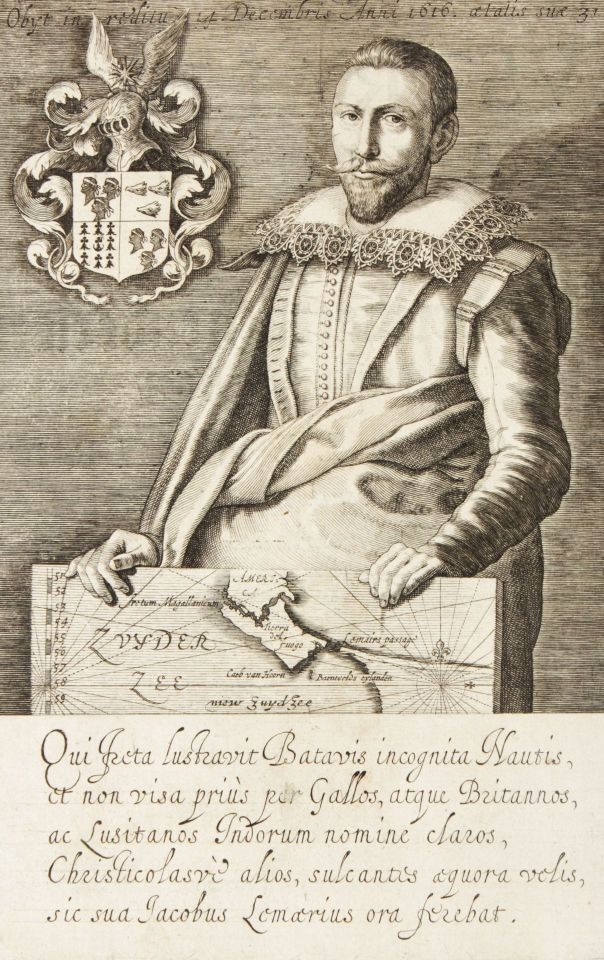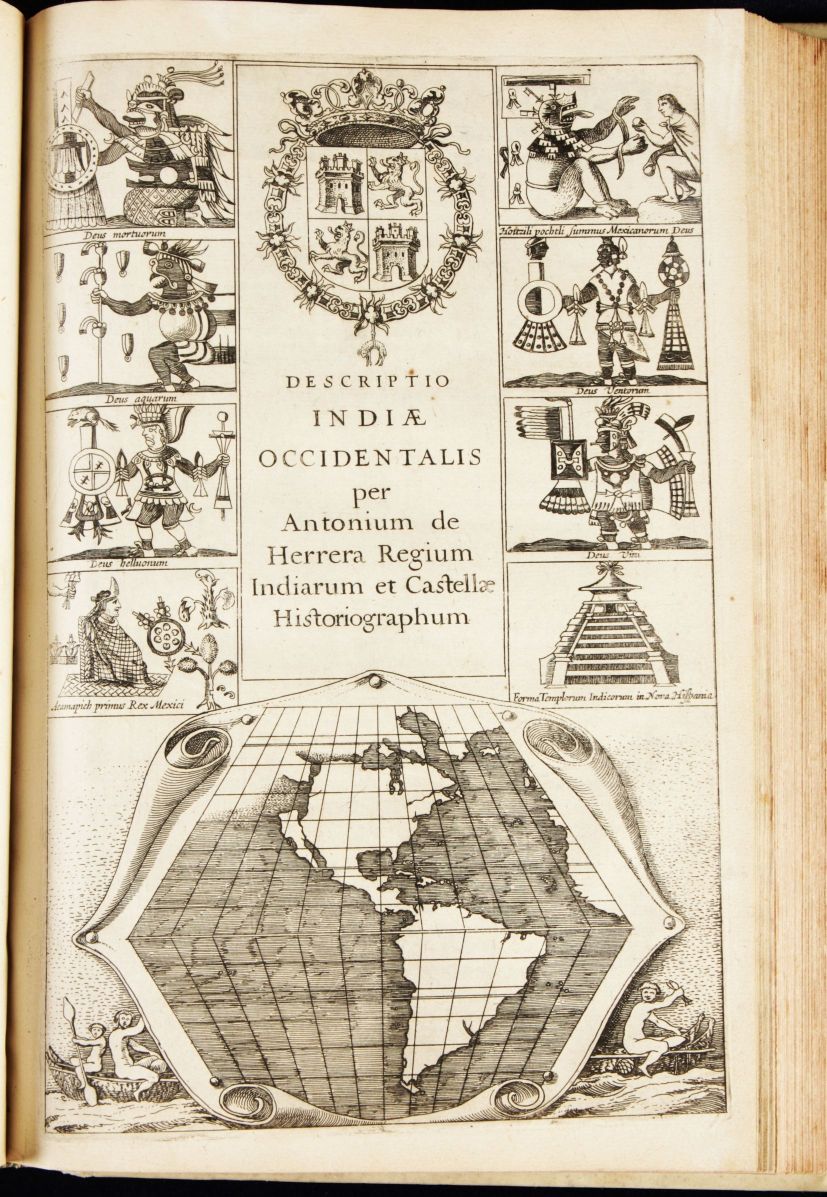Terra Australis: de role of the Dutch
The Dutch were late in participating in the European voyages of discovery and conquest in the XVI and XVII century. In the discovery of Australia and New Zealand their role was relatively more substantial. Terra Australis stood for the huge southern continent that earlier geographers supposed to exist to keep the world upside right. It contained the landmass and larger and smaller islands that covered the southern part of the globe and area that became gradually known and named when the southern end of Ptolemy’s concept, 20 degrees south, started to be challenged in the late XV century.
The Portuguese, rounding Cape of Good Hope in 1488, had reached 35 degrees south. Magellan, sailing through the Strait named after him (1520), had reached 52 degrees south, whereas le Maire rounded Cape Horn (1616) only a few degrees further south, 58.59 to be precise. The Arctic circle had not yet been passed.
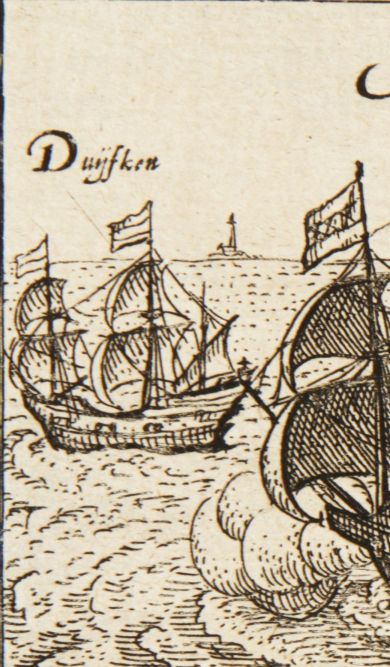
|
| Het Duyfken in 1598
Source: Journal du voyages…, Middelbourg, Langenes 1598 |
When the Dutch endeavoured to sail to the Indies in 1595 they sailed on 3 ships and one boat: het Duyfken. …‘t Pinasken genaemt het Duyfken groot omtrent 30 last, gemonteerd met 20 man; twee metalen stukken…schipper Simon Lambertszoon Mau. That Pinasken, (image) is the one that was used by Willem Janszoon when he explored the east coast of the Gulf of Carpentaria in 1606. Janszoon had followed the south coast of New Guinee, passing by the Strait of Torres without entering it, and then followed the east coast of the Gulf of Carpentaria till 13,5 degrees South. He left no report that we know of, but his departure from Bantam and return are described by the English captain Saris who was in Bantam at the time (Heeres 1899, IV, V and VI)
Le Maire, Kaerte van de Zeylage….Zuydzee, 1622
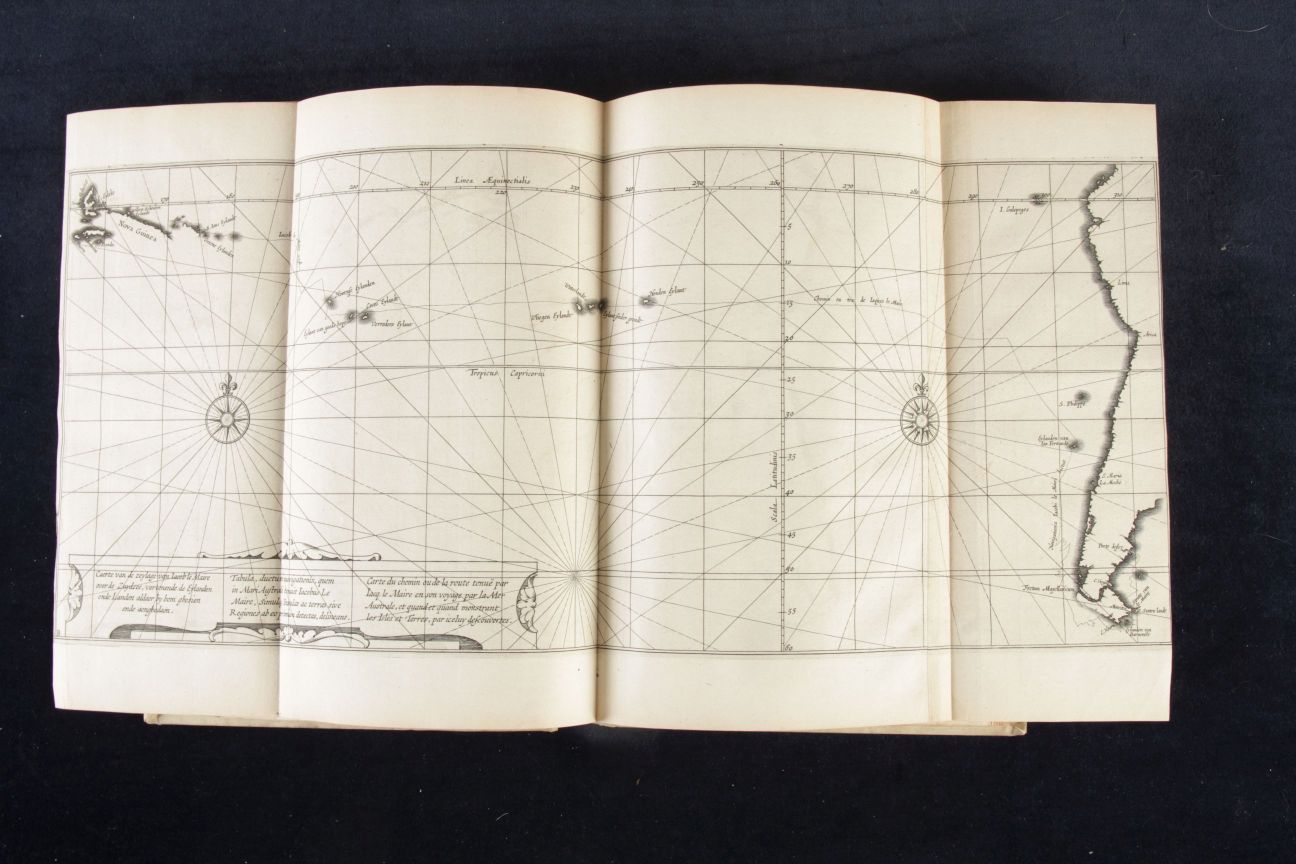
From: le Maire, Spieghel der Australische navigatie…. Amsterdam Colijn 1622 |
The next better documented involvement of the Dutch with Terra Australis is the voyages of Jaques le Maire and Willem Schouten who approached the Indies from the West. They had to avoid Magellan’s Strait and, sailing further south, discovered the Strait of le Maire and rounded what they named Cape Horn at 58 degrees and 59 minutes on entering the Pacific. Sailing north into the Pacific to about 15 degrees S. and then, followng the stream sailing West they discovered Honden Island (Puka-puka) et al and Hoornse islands (Niufoóu) et al before hitting the north coast of New Guinee, just under the Equator and reaching the Moluccas (Image of the Map in le Maire,1622) and thereafter Bantam on Java in October 29, 1616.
Their ship and cargo decommissioned, themselves imprisoned by the Dutch authorities in Bantam for breaching the monopoly of the VOC on the passage of Magellan’s Strait, they were to be brought to justice in Holland. Schouten and le Maire sailed with Spilbergen on December 14, 1616. Le Maire died on the way back, December 30, 1616. Schouten arrived in Holland on July 1, 1617 on the ship de Zeeland and, once back home, claimed the discoveries in South America and the Pacific for himself in a book published in 1618 . Le Maires log book only became known in the Netherlands in 1619, included in Spilbergen’s Oost en West Indische Spiegel of 1619. Le Maire’s full story was first published in 1621 in le Maires own book: Spieghel der Australische Navigatie, Amsterdam 1621. It is these texts, maps and plates we examine here now and offer for sale. Following the trail and timeline we mention (1) and (2) and (3) :
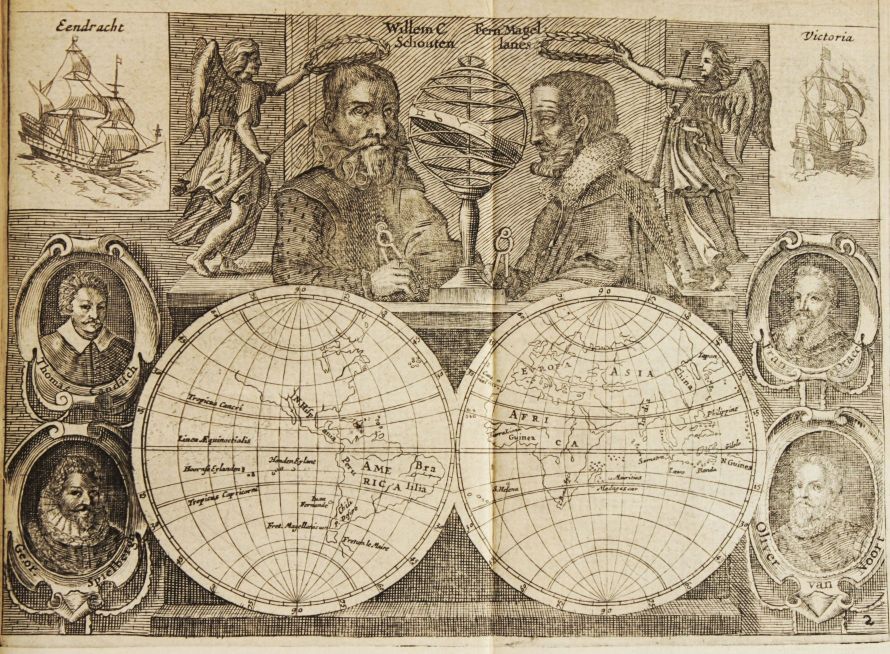 |
|
|
1. Schouten, Willem |
|
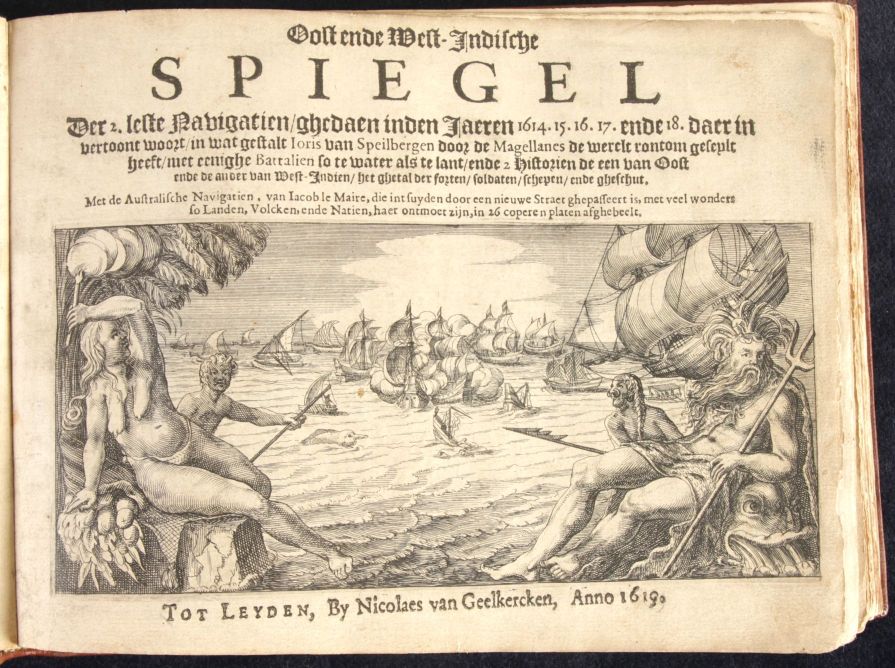
2. Spilbergen, Joris van
Oost en West Indische Spiegel….in Dutch, 1619
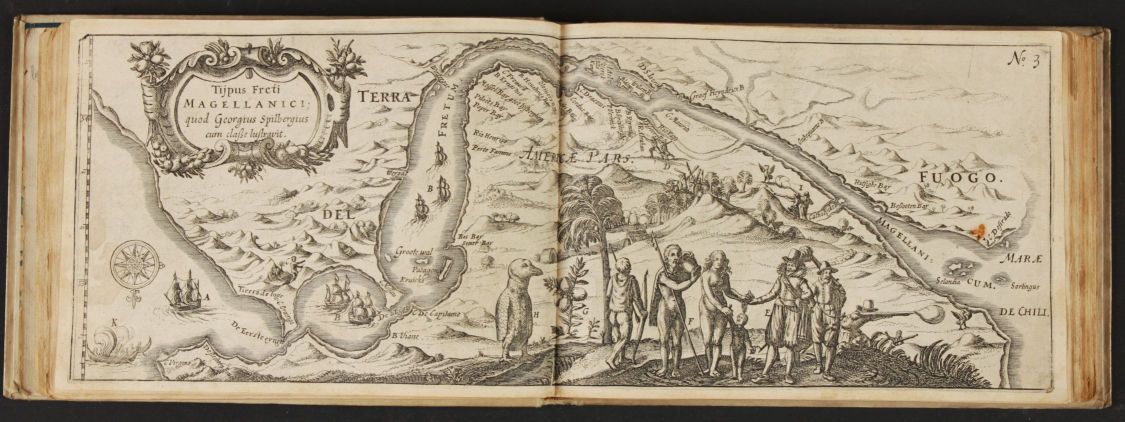
3. Le Maire, Iacob Spieghel der Australische navigatie. In Dutch. Amsterdam, Colijn, 1622 (three books in one volume: with Herrera – Descriptio Indiae Orientalis, Amsterdam 1622, and Ordoñez - Eyghentlijcke Beschryvinghe van West-Indien… Amsterdam 1621)
|
|
|
These three books together offer some interesting issues for comparative analysis and rich illustrative material.
The first is the human perspective: Father Isaac le Maire, an important investor in trade with the Indies and the VOC. With his investment of 85.000 Florins in the VOC he was its biggest investor and so Isaac le Maire becomes one of the Heren XVII, the VOC Board of Directors. He remains Governor till 1605 (van der Straaten, 2016: 108). After 1605 le Maire becomes the fiercest opponent of the VOC and attacks its privileges.
His first, unfriendly, action is to sell VOC shares widely at a certain price and to start negative rumours about the VOC’s chances thereafter. He buys the shares back at a far lower price, an early case of naked short selling. The VOC’s value falls to a historical low in 1609.
Isaac la Maire continues his fight with the VOC, conspiring with the French to create the French East Indian Company.
Finally, after creating his own Australian Company in 1614 he sends out his son on a voyage to the Indies through the Pacific. Having seen the reports of Drake (1577) and de Quiroz (1612, Claeszoon, Amsterdam) the old man concluded there is a way South of Magellan’s Strait to reach the Pacific. He instructed his son accordingly. In that way the monopoly on the passage through Magellan’s Strait by the VOC could be avoided. The primary motive was to establish trade with the Indies in his own right. The son discovers the route around Cape Horn but upon reaching Bantam his ship and all its cargo is decommissioned and le Maire is imprisoned by Jan Pieterszoon Coen. Sent back home with Spilbergen who was on his way back from molesting Spain’s Pacific ports in Chile and Peru, the son dies en route and his skipper, Willem Schouten, claims le Maire’s discoveries. In spite of this claim both le Maire and Schouten respectfully mention each other in all three books!
Another interesting perspective of these three books together is the view they offer on the role of the Dutch at this episode of the European voyages of discovery. The Dutch were fully involved in their war of liberation against the King of Spain which started in 1568. Frustrated by levies to be paid (one tenth of all economic movement) and proud to be protestants the fight moved like the waves of the sea with cities falling to Spanish forces and later again being occupied by the Dutch. The unification of Spain with Portugal in 1580 under one crown, that of Philips II, lead to the closure for Dutch ships of the Lisbon harbour and its oriental trade. From 1595 onwards the Dutch went on their own. They advanced aggressively and chased the Portuguese from Malacca (1606) while fighting the English for dominance in the Moluccas. They also explored the entrance into the Moluccas from the East. Olivier van Noort was the first Dutchman to pass through Magellan’s Strait and sail around the world (1602). Later Dutch expeditions included the aim of destroying the Spanish settlements on the Pacific coast of South America.
The three books presented here document these efforts of establishing a dominant position in (oriental) trade in developing an approach from the West and at the same time fighting Spain (and Portugal). All of this while an official armistice was in place between Holland and Spain between 1609 and 1621. Peace did not reach that far!!
Finally the three books provide a nice overview of European knowledge of South America, the Pacific and the search for the Southland. Herrera’s and Ordonez Beschrijvinge(n) provide an overview including maps of mainly Spanish knowledge of the Americas and the Pacific at the time. The Spanish called the Pacific a Spanish lake! Spilbergen’s order to molest the Spanish settlements on the Pacific coast and bring back spices from the Indies shows the warlike situation around 1620, even if peace was official. America was far away! Finally the exploratory voyage of le Maire and Schouten showed a new way to the Indies. Father Isaac le Maire, retired into the dunes of Holland, fought the legal battles for his son, a fight he eventually won. Le Maire got his due and his son the name of the Strait he discovered.
Bibliography:
Heeres J.E. The part borne by the Dutch in the discovery of Australia, London, Luzac 1899
Straaten, Alban van der: De Belgische ontdekkingsreizigers. Lanoo. 2016
Engelbrecht & Herwerden: De ontdekkingsreis van Jacob le Maire and Willem Corneliszoon Schouten, den Haag, Nijhoff 1945
i De eerste Schip-vaerdt der Hollandsche NATIE in Hartgers 1648. The other three ships were 3 times bigger and carried up to 100 last.
ii Schouten, Willem Corneliszoon; Journael ofte Beschrijvinghe…reyse in de jaren 1616, 1617 and 1618, Amsterdam, Willem Janszoon (= Blaeu). 1618
iii The three books have their complete and separate descriptions further on.



